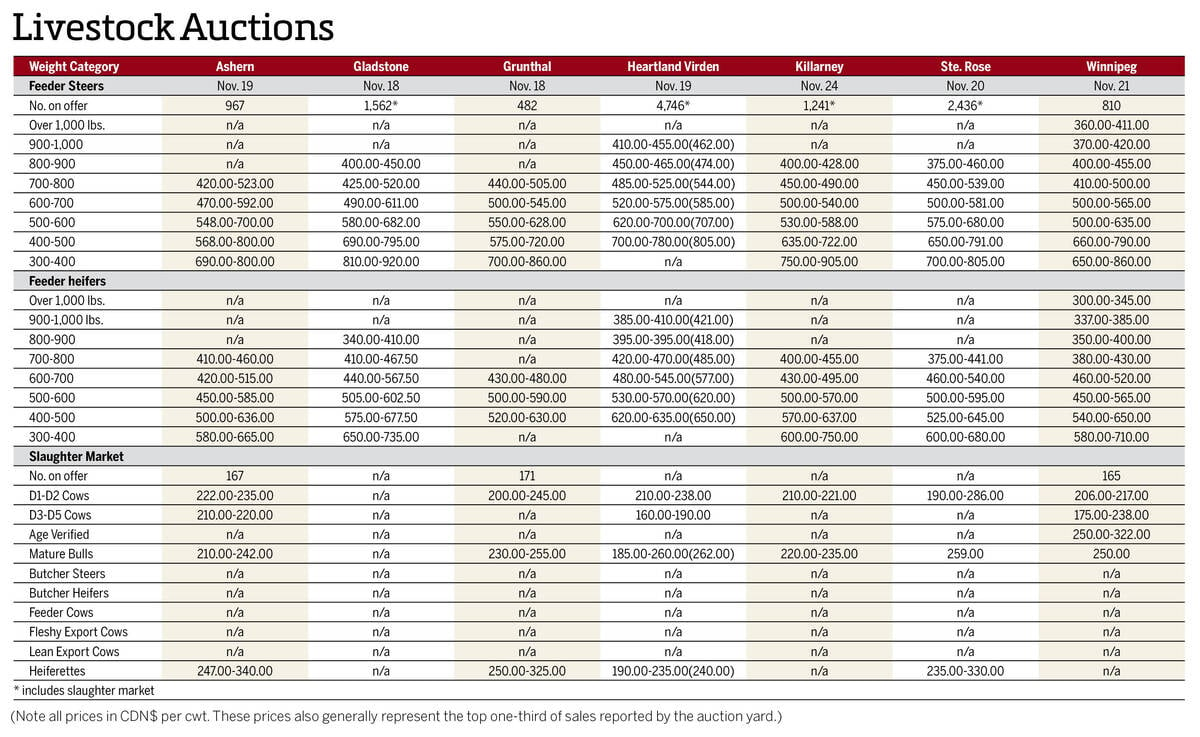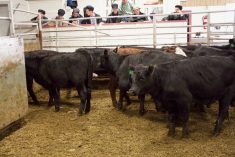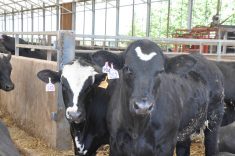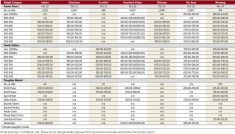High calf prices have been a good news story for cow-calf producers, but they’ve done little to help Canada recover its diminished beef herd.
“This is an unheard of scenario,” said Matthew Atkinson, president of Mantioba Beef Producers and Neepawa-area cow-calf producer. “We have record cattle prices, relatively cheap money (low interest rates), and we also have low feed costs and an abundance of feed.”
Why it matters: Canada’s beef herd has been slipping for years.
Read Also

Manitoba cattle prices – Nov. 24
Cattle prices from Manitoba’s major auction marts for the week of Nov. 18-24.
Instead of incentivizing producers to rebuild herds, however, anecdotal evidence has a surge of producers getting out of the business in recent years.
Official cattle numbers have also slid, helped along by the 2021 drought. Statistics Canada reports that, from 2021 to 2022, the province dropped 7.7 per cent of its cattle on beef farms, down to 928,900 head.

There’s been little sign of recovery since that historic drought year. Statistics Canada has reported fewer beef animals every year in Manitoba and, in 2024, only 882,600 beef cattle were reported. Nationally, cattle numbers also failed to bounce back. Statistics Canada put Canada’s beef herd at almost 10.78 million in 2021. In 2024, the estimated beef herd was 10.08 million.
Atkinson said he is shocked by the number of herd dispersals, even from big, diversified herds. He cited one recent conversation with an auction mart manager. The auction had fielded only one call from a person looking for cows, but a steady stream of herd dispersals booked for the fall.
“That’s really disappointing,” Atkinson said. “Because everybody’s really wanted this higher price; they wanted to be profitable; they wanted all of this. And now that it’s here, everybody’s getting out.”
Rick Wright, executive administrator of the Livestock Markets Association of Canada, said it’s a trend he’s seeing across Western Canada.
“By the time we get the numbers in, in December, we’ll probably see another decrease in the number of beef cows,” he said. “We have a number of producers that are close to retirement age that have made peace with the taxman, and they’re dispersing their cows this fall.”
Summer prices have been very high, and Wright said that producers have been agressively weeding out animals to sell. While the herd decrease might not be as big as it was last year, when drought was still hammering the western Prairies, he doesn’t see a turnaround in the near future.
Heifer price is also quite strong, and that is putting downward pressure on heifer retention.
“It’s pretty tempting for these producers to sell those heifers and turn them into cash flow, and so we’re not seeing heifer retention like we have done in other years,” Wright said.

Feed resurgence
Most of the Prairies have gotten a better forage year this season than the previous two years. That has lowered the strain of purchased feed costs and potential shortages.
The abundance of feed, combined with strong calf prices promising profit, could ease the pressure sending cattle and cattle farmers to the door.
“We could see a bit of a correction coming before Christmas time, but certainly, the cow-calf guys are in the driver’s seat again this year and are going to get good returns, and that should encourage guys to take a look at getting their numbers back up,” Wright said.
Scraping bottom
That’s likely not going to be enough to move the needle on the national herd size in the short term, he cautioned, nor is it enough for American farmers, who suffered many of the same weather stresses as Canadian ranches and are also facing their smallest herd in decades, to start expanding again.
“We haven’t hit the rebuild cycle there yet,” said Wright. “In the cattle cycle, we’re probably at or close to the bottom, and if everything stays true to history, we should start to regain, but I think that this is going to get stretched out a little bit longer than what a lot of people think.”
He estimates that recovery is at least another year away.
That’s at least partly because of stubbornly high land prices, he argued.
Manitoba led the country last year in pasture land value increases, according to a spring 2024 report from Farm Credit Canada. The organization reported that Manitoba pasture land increased 19 per cent through 2023, citing higher demand.
Manitoba Beef Producers argued that those parcels have not been in demand for livestock, but to be converted to grain, which, until recently, was also enjoying high prices.
“It’s hard to buy land that you can afford to put cattle on, and that’s been a limiting factor as well. And even though the grain seems to be on the down slide right now, it hasn’t affected the land prices. They’re still very strong,” Wright said.

Track running out?
While beef cattle prices have been slow to deflate, Wright noted that the prospect of a sudden market dip has some producers wary.
“The last time we had a real good bump, it lasted for about 14 months and then we had a major correction. There is a lot of anxiety out there with producers right now as to when the next correction is coming.”
That anxiety isn’t misplaced, he added. There are signs that a correction might already be underway.
“Right now, the harvest price from the packing plants looks like it’s peaked,” he said. “It’s actually dropped considerably here, in the last couple of months.”
And while the export market has been good for beef and demand remains high, Wright says that market may also be close to peaking.
“One of the things that’s going to offset the meat market (demand) is this beef on dairy program we’ve seen become more prevalent over the last 18 months, especially in the US. Animals that can be fed and put into the meat program are going to produce a lot more pounds of beef. So, we may be short of cattle as far as beef cattle goes, but we won’t be as short as of meat.”
If that export market has peaked, Wright said the only thing keeping feeder cattle at their current high prices is the prospect of cheaper feed in the fall.
Business risk management gaps
Atkinson said that better and more affordable business risk management tools would go a long way to reduce producer anxiety.
That has been a long-time ask of the beef sector. Industry groups like Manitoba Beef Producers have argued that beef does not have the same publicly supported insurance options as the grain industry, where AgriInsurance premiums are cost-shared with government.
“We have things like livestock price insurance (LPI), but we’ve seen our neighbours to the south go to a cost share on it, like we see with crop insurance, and the uptake on it is amazing,” said Atkinson. “LPI is a great program, but a big chunk of the profit on those calves is taken out to enroll in it.”
The program, which is designed to protect farmers against market volatiliy, insures calves to a base price and pays out should the market fall below that insured price.
“During the BSE crisis, when everybody was scrambling, if we had an affordable LPI that had a high uptake, it would (have taken) care of that current inventory and give you time to rebuild,” Atkinson said.
















